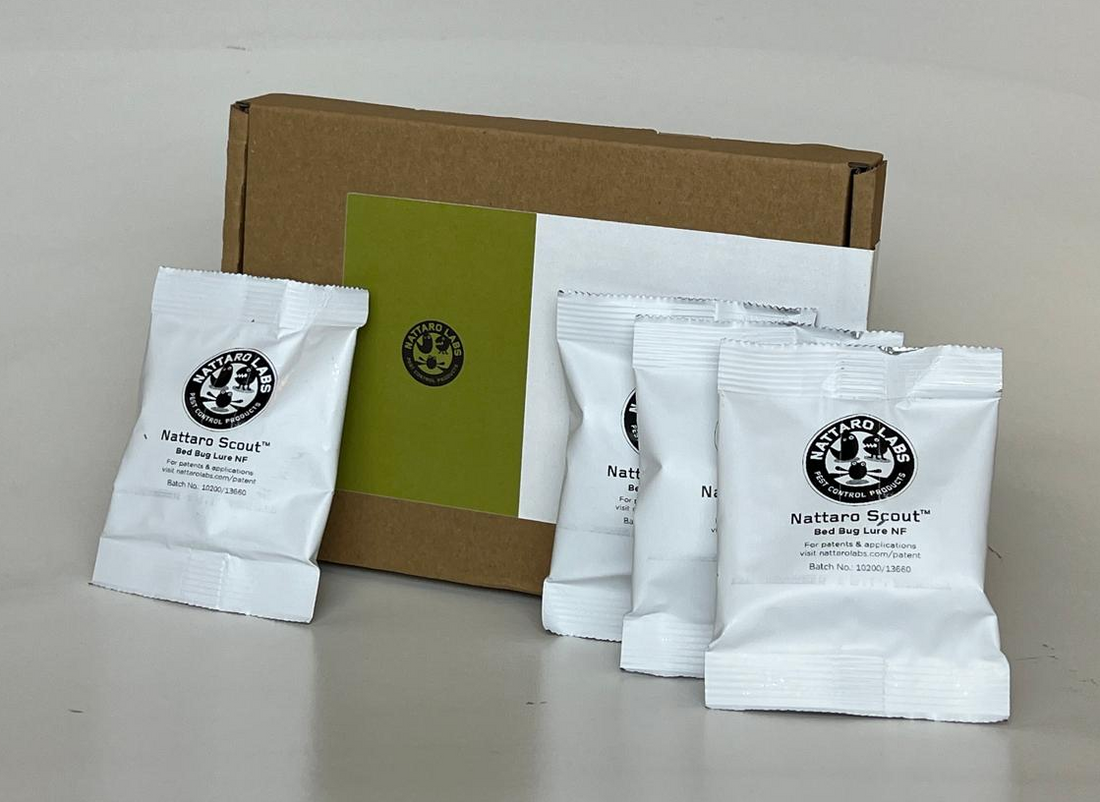Reports of bites can be difficult to use to pinpoint a source with bite marks which can be similar to fleas, mosquitoes or unrelated mild allergic reactions, in addition to the varying time between bed bug feeding and bite symptoms showing, or maybe no reaction to the bite at all.
It is impossible to prevent bed bug introduction to a property. With the above-mentioned challenges in identifying when bed bugs are present, and the rapid potential population growth making their control increasingly difficult, bed bug detection traps are an essential part of a bed bug monitoring program.
Whilst visual inspections can be used, and are particularly effective at higher bed bug populations, as well as sniffer dogs, both of these can be costly and are tools better used to confirm an infestation and plan a treatment rather than proactive regular monitoring. Using Nattaro Scout bed bug detection traps are a discrete cost-effective way to constantly monitor for the presence of bed bugs.

How to use Nattaro Scout bed bug detection traps
- Identify where the traps are going to be placed. The best place is between where the bed bug are likely to be hiding (their harbourage) and where they will move to to feed.
- On a likely travel route where the bed bugs will come into contact with the detection trap
- Bed bugs like dark locations, so the trap should be placed away from light as much as is possible.
- Somewhere where the trap will remain undisturbed from day-to-day activities apart from when being checked.
- Open the white bag and place the lure inside the trap.
- Do not try to open the lure, it has been designed to allow the scent to be emitted through the plastic capsule.
- The plastic capsule containing the attractant means there is no mess, stickiness or exposure to the attractant.
- Slide into the holder clip.
- This clip protects the opening of the trap keeping it open even if the trap is placed underneath a mattress so bed bugs can always get in.
- Place the detector trap on a flat surface to prevent the bed bugs which fall into it from being able to climb out.
- Check the trap (both inside, outside and around the trap) regularly.
- Replace the lure every 4 weeks.

9 out of 10 bed bug infestations originate in the bed, this is therefore the best place to start a search. As well as beds, bed bugs will also rest anywhere suitable near to their hosts, for example on commonly used furniture such as sofas and resting chairs in care homes. Regardless of the situation the Nattaro Scout is being used the same best practice principles apply:
- Locate on an expected route from hiding to feeding place
- Place in a dark location
- Rest the bed bug trap on a flat surface
- Use two traps per piece of furniture being monitored
- Replace the lure after 4 weeks.
Where to place Nattaro Scout traps on a bed to monitor for bed bugs:
- Place traps at the head end of the bed. This is likely to be closer to where the bed bugs are resting.
- Place two traps on each bed, one on either side.
- Ideally place the traps between the mattress and the bedframe. The patented design of the clip prevents the trap entrance being closed even if an object such as a mattress covers the trap.
- If locating the traps between the mattress and the bedframe is not possible, place the trap on the floor at the foot of the bed legs, ensuring they are in the darkest place
Advantages of Nattaro Scout:
-
High hit rate of over 90% giving the user confidence.
- If bed bugs are present the detector trap will catch one
- If there are no bed bugs in the detector trap, it is because there are no bed bugs present
-
Unique attractant catches bed bugs even at low population levels.
- Allows earlier treatment with more chance of success
- Earlier identification of bed bug populations before they become large enough to spread within a property.
- Patented trap design allows positioning between bed mattress and bedframe getting the trap closer to where it needs to be to attract active bed bugs.
- Reusable trap, simply replace the lure. What's more it is more environmentally friendly as, the trap is made out of plant-based plastic.

Where to place Nattaro Scout traps on a sofa or chair to monitor for bed bugs:
- If it can be lifted off, place the traps underneath the base cushion
- For a single chair use one trap, for a sofa for two or more people use two traps, one located at either end arm.
- Place the traps towards the back of the chair, closer to where the bed bugs may be resting in the folds of the fabric.
- Position the traps so that they are flat to prevent trapped bed bugs being able to climb out and escape from the trap
- If locating the traps between the base cushion and chair frame is not possible, place the trap on the floor at the foot of the back legs, ensuring they are in the darkest place

